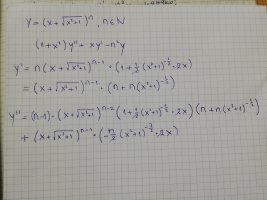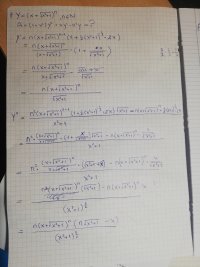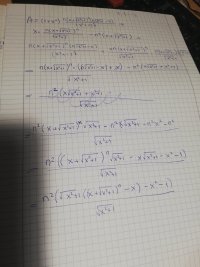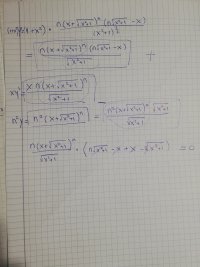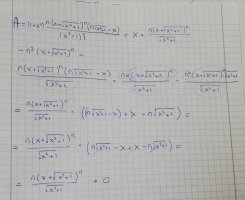You are using an out of date browser. It may not display this or other websites correctly.
You should upgrade or use an alternative browser.
You should upgrade or use an alternative browser.
Derivative
- Thread starter Loki123
- Start date
I just get lost after applying the derivatives in the expressionKeep going. You are on the right path.
D
Deleted member 4993
Guest
Now just use those y' and y" and evaluate the given expression. It is a dreary calculation but doable.We have what y is (first line). We are supposed to calculate the expression under it (second line). It gets too complicated. Is there a trick? View attachment 32257
Do you have the expected answer?
BigBeachBanana
Senior Member
- Joined
- Nov 19, 2021
- Messages
- 2,277
Let [imath]f(x)=x\quad \&\quad g(x)=\sqrt{x^2+1}[/imath]We have what y is (first line). We are supposed to calculate the expression under it (second line). It gets too complicated. Is there a trick? View attachment 32257
[math] y=(f+g)^n\\ y'=n (f+g)^{n-1}(f'+g')\\ \tag{Product rule} y''=n(n-1)(f+g)^{n-2}(f'+g')(f'+g')+n (f+g)^{n-1}(f''+g'') [/math]Find [imath]f', f'',g', g''[/imath],plug in and simplify.
No, I have 4 possible answersNow just use those y' and y" and evaluate the given expression. It is a dreary calculation but doable.
Do you have the expected answer?
BigBeachBanana
Senior Member
- Joined
- Nov 19, 2021
- Messages
- 2,277
I did it again. I got 0. Is it correct? View attachment 32262
simplify (1+x)^2(n*(sqrt(x^2+1)+x)^n*(n*sqrt(x^2+1)-x))/(x^2+1)^(3/2)+x(n*(sqrt(x^2+1)+x)^n)/sqrt(x^2+1)-n^2(1+sqrt(x^2+1))^n - Wolfram|Alpha
Wolfram|Alpha brings expert-level knowledge and capabilities to the broadest possible range of people—spanning all professions and education levels.
It's just simplify. I don't see the answer.simplify (1+x)^2(n*(sqrt(x^2+1)+x)^n*(n*sqrt(x^2+1)-x))/(x^2+1)^(3/2)+x(n*(sqrt(x^2+1)+x)^n)/sqrt(x^2+1)-n^2(1+sqrt(x^2+1))^n - Wolfram|Alpha
Wolfram|Alpha brings expert-level knowledge and capabilities to the broadest possible range of people—spanning all professions and education levels.www.wolframalpha.com
Oh I forgot *0 in the last lineNo, the last line is horribly wrong.
Basically you are saying that if 9*0=0, then 9 = 0. NO! 9=9, 9 does not equal 0!
Steven G
Elite Member
- Joined
- Dec 30, 2014
- Messages
- 14,596
OK!Oh I forgot *0 in the last line
so it is 0?
Steven G
Elite Member
- Joined
- Dec 30, 2014
- Messages
- 14,596
I'm sorry but there is too must work to look through. Please try using a website that will just give you the answer. I hope that you understand. I might miss something that you did wrong. Also getting 0 probably means that you are correct.

